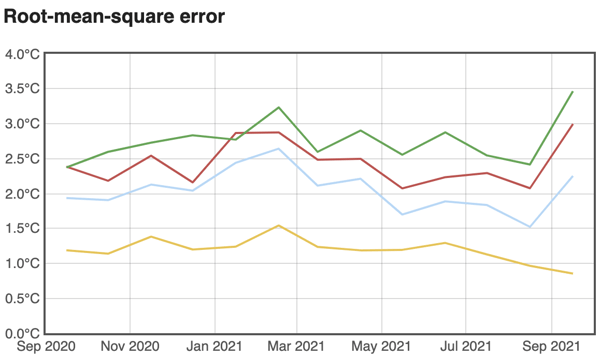Forecast Accuracy
The Accuracy and Quality of Weather Forecasts
Foreca has repeatedly won forecast quality comparisons against competing service providers.
Weather forecasts should be as accurate as possible in order to avoid harmful decisions and their possibly dire consequences in business. For over two decades, Foreca has closely cooperated with important clients, providing weather forecasts in a responsible, dependable manner. Continued development of ever more accurate forecast methods ensures Foreca's position as one of the most accurate and responsible weather service providers in the world.
Unlocking Precision: Foreca Weather Forecasts
At Foreca, we blend cutting-edge technology with meteorological expertise to provide you with reliable, intelligent weather forecasts. Here’s how we do it:
- Smart Data Utilization:
- Our forecasts are powered by state-of-the-art weather models and advanced data processing methods.
- We curate and optimize data sources to ensure the highest quality and relevance.
- AI-Driven Accuracy:
- Machine learning and AI play a crucial role in our forecast production.
- These dynamic algorithms continuously evolve, enhancing our accuracy.
- Nowcasting for the Present Moment:
- When it comes to short-term predictions (hours to minutes ahead), we turn to AI.
- Real-time data from radar imagery, satellite observations, and atmospheric sensors allow us to swiftly adapt to changing weather conditions.
- Refining Our Models:
- Feedback loops and automated learning mechanisms keep our AI models sharp.
- As new data becomes available, our algorithms fine-tune themselves, resulting in more precise forecasts over time.
- Patterns and Trends:
- By analyzing historical weather data, we identify patterns and trends.
- This knowledge helps us anticipate future weather conditions accurately.
- Local Insights Matter:
- We consider local topography, land use, and other factors.
- This personalized approach ensures accurate forecasts, even in areas with diverse microclimates.
Foreca: Your partner in planning, whether it’s for your daily commute or strategic business decisions. Trust us to deliver weather insights that empower you.

Our Data Sources
Foreca seeks to use all the data sources fit for a particular forecasting point/territory. The choice of sources strongly depends on data reliability, stability of data flow from sources and various other factors which are part of a complex data selection algorithm Foreca employs. In total, Foreca gathers and fuses 50+ different data sources world-wide.
The following is a non-exhaustive sample of current incoming weather data providers:
- European Centre for Medium-Range Weather Forecasts ECMWF
- Europe’s meteorological satellite agency EUMETSAT
- Copernicus Climate Change Service C3S
- National Oceanic and Atmospheric Administration NOAA (United States)
- Met Office (United Kingdom)
- Deutscher Wetterdienst DWD (Germany)
- Météo-France (France)
- Zentralanstalt für Meteorologie und Geodynamik ZAMG (Austria)
- Finnish Meteorological Institute FMI (Finland)
- Japan Meteorological Business Support Center JMBSC (Japan)
- Koninklijk Nederlands Meteorologisch Instituut KNMI (Netherlands)
- Korea Meteorological Administration KMA (Korea)
- Agencia Estatal de Meteorología AEMET (Spain)
- Sveriges meteorologiska och hydrologiska institut SMHI (Sweden)
- Central Weather Administration CWA (Taiwan)
Foreca has integrated over a dozen different weather models into its system. To put it simply, Foreca seeks to provide the best possible forecasting output for a forecasting territory, whether an in-house model output or some 3rd party solution, including government services. The choice was made after thorough comparisons of data sources and constant sensing of latest offerings available in the field of meteorology. The data selection process is constant, and Foreca continuously adds new data sources, sometimes dropping old ones, if they no longer perform up to expectations
Additional Sources
It is also possible to integrate sensor data from cars or private stations into the Foreca prediction system. Though Foreca has the capacity and successful history of assimilating data from private stations, they are usually part of customised services and the standard global offering does not include them. Adding private weather stations to the service is subject to separate commercial and technical discussions.
Post-Processing Methods
Foreca uses a number of post-processing methods, including various versions of dynamical multi-model MOS and Kalman filtering, to improve the raw numerical weather prediction (NWP) output. Foreca uses sophisticated statistical analysis to reduce forecast errors as much as possible by using all the available data from multiple weather models, both global and local, and all available measurement parameters. The system has been developed over the course of many years.
It is also possible to fine-tune the model forecast with measurements that have been taken after the model was initialized. This is called nowcasting, and it is an effective technique when forecasting a few hours into the future. Foreca Nowcasting System fuses radar, satellite and weather station measurements and runs a new high-resolution nowcast several times per hour, improving both the resolution and accuracy of the first hours’ forecast. Some institutions and companies are even able to provide measurements every 5 minutes, so Foreca purchases them for nowcasting, along with fresh radar and satellite data.
Verifications
Since forecast verification is an essential part of a weather service, Foreca's verification activities are extensive. Foreca uses various verification tools to continuously monitor the quality of all forecasts: real-time comparison of latest forecasts vs latest observations and continuous longitudinal verification studies for improving our forecasting engine and methods.
All the data sources are verified, and the best verifying method for any given location is automatically chosen. Our tools allow detailed drill-downs to arbitrary stations and times and comparison of any data sources. The most important data sources are additionally scored against each other with a global score sheet that calculates the statistical significance of one source truly outperforming the other in a given region, providing a global birds-eye view. Foreca has concentrated on methods that make sense globally, though some market-specific methods are included. In addition, case studies by meteorologists are done every year on a topical subject.
We benchmark our forecasts against the major global models GFS and ECMWF. There is large variation in accuracy comparison between countries and months, but Foreca clearly beats the global models on a regular basis.

An example of verification between Foreca short (yellow) and long forecasts (blue) in comparison to observations realised afterwards. As benchmark information, red and green lines represent the accuracy of corresponding global model forecasts. The verification can be done to each weather parameter when and where observed.
Quality Management Process
Our Key Components of Quality:
Yearly scale: the backbone of long-term quality over the years is personnel training. The technologies and methods behind the forecasts are developing constantly; if we did everything the way it was done five years ago, we would be much less accurate than where we are today. Foreca participates in meteorological conferences, seminars and contributes to open-source weather software development
Quarterly scale: monitoring the global score sheet and other verifications helps direct attention. The global score sheet calculates the statistical likelihood that a given data source performs better in a given region.
Day-to-day scale: continuous feedback processing from Foreca's consumer services provides invaluable hints about issues that might escape other forms of checks, for instance, in locations that do not have weather stations. Examples of issues identified and fixed thanks to such feedback: wrong altitude or coordinates for a location, faulty weather station data that was good enough to pass automatic checks, misbehaving MOS in a coastal location
Minute-by-minute scale: reliable data processing is a key component, since a late forecast is a bad forecast. Foreca data processing quality monitoring is forced via the Foreca task execution/monitoring system: to be able to incorporate any new data into Foreca systems, it must be included in the task monitoring, which is programmed to force the developer to answer key metrics like “what dependencies exist?”, “how much latency is acceptable?”, “who should get the alarms in case of an error situation?” etc.
Read more: How are weather forecasts made?